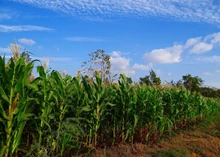
Depending on the scale, floods have different effects on food security, with declines likely at smaller scales but mixed effects at national and regional scales. Souloukna Mourga walked through his flooded millet and cotton field in northern Cameroon, uprooting soggy stems with a few bolls. 6 hectares of mostly dead crops were submerged. The 50-year-old father of 12 is one of an estimated 4 million people, many of whom are small subsistence farmers, in more than a dozen West and Central African countries whose crops have been decimated by unusually heavy flooding.
Floods have destroyed this season's harvest, while nearly 1 million hectares of farmland across the region remain under water, washing away soil nutrients and setting the stage for even worse crop production next season. Hundreds of hectares of crops and dotted huts in hamlets remain submerged around Mourga's farm in Dana village on the floodplain of the Logone River, which borders Cameroon and Chad.
"I'm out of options. We are experiencing famine. I have two wives and a total of twelve children. Everything has been taken by the water," Mourga said. Bernadette Handing, 37, took two hours in a canoe to reach her flooded millet farm in Kournari, south of Chad's capital, some 300 kilometres (186 miles) north of Dana on the floodplain between the Logone and Chari Rivers. "What I was able to save from the farm will not be enough to sustain our family for a month. We will die of hunger in the winter," she predicted.
According to Sib Ollo of the World Food Programme, the West and Central African region were already facing a dire food security situation prior to the floods. Prolonged drought last year, conflict in the Sahel region that has displaced nearly 8 million people, the majority of whom are farmers, the pandemic that has disrupted farming, and the fallout from the Ukraine crisis, which has curtailed fertiliser supplies to the region, all meant that crop output would be low. "This is a once-in-a-lifetime opportunity," Ollo said. "This is a perfect storm of factors all working together to lead us to a catastrophe, a major crisis."
Before the floods, the region's food insecurity and need for aid totaled more than 40 million people, according to Kouacou Dominique Koffy, head of the Food and Agriculture Organization's West Africa emergency and resilience team. Koffy stated that 80% of those who had recently been displaced were agro-pastoral farmers and that it would take time for them to return and for the water to recede before they could resume farming. Floods in Nigeria have destroyed more than 570,000 hectares of farmland, according to Sadiya Umar Farouq, minister of humanitarian affairs and disaster management Crops such as rice, maize, and small grains are being lost in the northeastern and middle belt states, where the majority of Nigeria's food is grown.
According to Edwin Chigozie Uche, president of Nigeria's Maize Growers and Processors Association, preliminary reports indicate that up to 30% of the maize crop in the two regions could have been lost due to flooding, raising the prospect of food shortages. "We've begun collecting soil samples in flood-affected areas to assess nutrient levels. Farmers will need time to get back to farming," Uche said.
Goni Alhaji Adam, chairman of the northeastern Borno state Associations of Sorghum Producers, Processors, and Marketing, said the flooding was the worst he had seen in two decades. "Because of the devastating floods, we are very concerned about farming next year.
Because the topmost layer of soil, which contains high nutrients, has been washed away, leaving the soil dead, the possibility of not being able to farm is very high." Many are small-scale farmers who cannot afford soil fertility tests and other farm management methods and will be unable to farm next year without assistance, but even if they do receive assistance, he fears that it will be insufficient.











